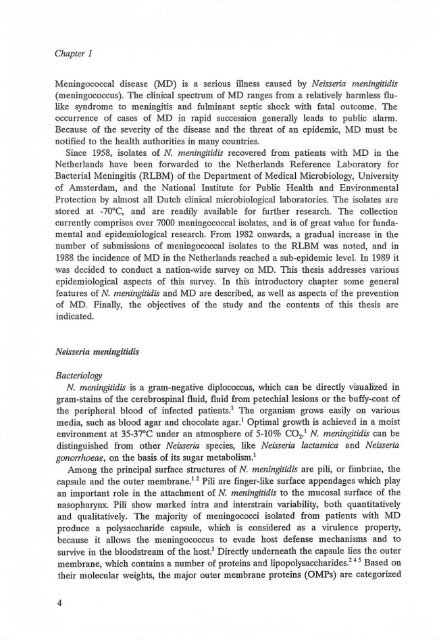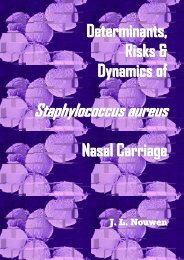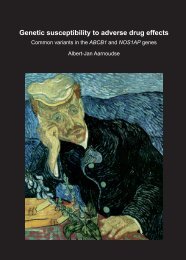An attempt at an epidemiological explanation - Epib.nl
An attempt at an epidemiological explanation - Epib.nl
An attempt at an epidemiological explanation - Epib.nl
- No tags were found...
You also want an ePaper? Increase the reach of your titles
YUMPU automatically turns print PDFs into web optimized ePapers that Google loves.
Chapter 1Meningococcal disease (MD) is a serious illness caused by Neisseria meningitidis(meningococcus). The clinical spectrum of MD r<strong>an</strong>ges from a rel<strong>at</strong>ively barmless flulikesyndrome to meningitis <strong>an</strong>d fulmin<strong>an</strong>t septic sbock with f<strong>at</strong>al ou tcome. Theoccurrence of cases of MD in rapid succession generally leads to public alarm.Because of the severity of the disease <strong>an</strong>d the thre<strong>at</strong> of <strong>an</strong> epidemic, MD must benotified to the bealth authorities in m<strong>an</strong>y countries.Since 1958, isol<strong>at</strong>es of N. meningitidis recovered from p<strong>at</strong>ients with MD in theNetherl<strong>an</strong>ds have been forwarded to the Netherl<strong>an</strong>ds Reference Labor<strong>at</strong>ory fo rBacterial Meningitis (RLBM) of the Department of Medical Microbiology, Universityof Amsterdam, <strong>an</strong>d the N<strong>at</strong>ional Institute for Public Health <strong>an</strong>d EnvironmentalProtection by almost all Dutch clinical microbiological labor<strong>at</strong>ories. The isol<strong>at</strong>es arestored <strong>at</strong> _70°C, <strong>an</strong>d are readily available for further researcb. The collectioncurrently comprises over 7000 meningococcal isol<strong>at</strong>es, <strong>an</strong>d is of gre<strong>at</strong> value for fundamental<strong>an</strong>d <strong>epidemiological</strong> researcb. From 1982 onwards, a gradual increase in tbenumber of submissions of meningococcal isol<strong>at</strong>es to the RLBM was noted, <strong>an</strong>d in1988 the incidence of MD in the Netherl<strong>an</strong>ds reacbed a sub-epidemic level. In 1989 itwas decided to conduct a n<strong>at</strong>ion-wide survey on MD. This thesis addresses various<strong>epidemiological</strong> aspects of this survey. In this introductory cbapter some generalfe<strong>at</strong>ures of N. meningitidis <strong>an</strong>d MD are described, as well as aspects of the preventionof MD. Finally, the objectives of the study <strong>an</strong>d tbe contents of this thesis areindic<strong>at</strong>ed.Neisseria meningitidisBacterio[ogrN. meningitidis is a gram-neg<strong>at</strong>ive diplococcus, whicb c<strong>an</strong> be directly visualized ingram-stains of the cerebrospinal fluid, fluid from petechial lesions or the buffy-co<strong>at</strong> ofthe peripheral blood of infected p<strong>at</strong>ients.' The org<strong>an</strong>ism grows easily on variousmedia, such as blood agar <strong>an</strong>d cbocol<strong>at</strong>e agar.' Optimal growth is achieved in a moistenvironment <strong>at</strong> 35-37°C under <strong>an</strong> <strong>at</strong>mosphere of 5-10% CO,.' N. meningitidis c<strong>an</strong> bedistinguished from other Neisseria species, like Neisseria [actamica <strong>an</strong>d Neisseriagonorrhoeae, on the basis of its sugar metabolism.'Among the principal surface structures of N. meningitidis are pili, or fimbriae, thecapsule <strong>an</strong>d the outer membr<strong>an</strong>e." Pili are finger-like surface appendages whicb play<strong>an</strong> import<strong>an</strong>t role in the <strong>at</strong>tachment of N. meningitidis to the mucosal surface of tbenasopbarynx. Pili sbow marked intra <strong>an</strong>d interstrain variability, both qu<strong>an</strong>tit<strong>at</strong>ively<strong>an</strong>d qualit<strong>at</strong>ively. The majority of meningococci isol<strong>at</strong>ed from p<strong>at</strong>ients with MDproduce a polysaccharide capsule, whicb is considered as a virulence property,because it allows the meningococcus to evade host defense mech<strong>an</strong>isms <strong>an</strong>d tosurvive in the bloodstream of tbe host.' Directly underne<strong>at</strong>h the capsule lies the outermembr<strong>an</strong>e, whicb contains a number of proteins <strong>an</strong>d lipopolysaccbarides' 4 5 Based ontheir molecular weigbts, tbe major outer membr<strong>an</strong>e proteins (OMPs) are c<strong>at</strong>egorized4









